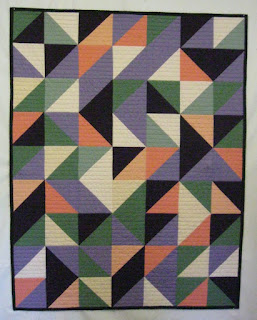My goal is to spend mornings in the studio, leaving other things for the afternoons (errands, desk/computer stuff). Working on the intricate piecing in Jeremy's wedding quilt is very demanding, so I've limited it to the making of one block a day, which can take me anywhere from 1-2 hours. That leaves me time for other sewing, something simpler. For the last month or so, that time has been spent working with daiwabo fabrics, a Japanese style of fabric I've used in some other projects, for example the placemats in
this post, and the dresser cover
here. I love the subtle range of taupes/tans/browns, even though I am not drawn to brown as a color either in other commercial fabrics or in hand-dyeing my own.
My friend Kathy decided that she was never going to use the large collection of daiwabo fabric that she had collected. I told her that if she would like to have someone else work with it, I would be happy to take on her collection. So, a sizable bin of these beautiful fabrics came home with me after our last quilting retreat in April. Thank you Kathy!! (Click on the image below for a better look at the range of texture/designs.)

My first thoughts about using the fabric are centered on making something for Kathy. She decided on a tablerunner, using the pattern "Get in Line" from our friend Amy Walsh, which I used for the table runner (link above). Cutting one 1.5" strip from each of the fabrics would give me plenty for a tablerunner for Kathy's dining room table. After cutting a few of those strips, I decided to line up a couple of other projects using these fabrics, and to do all the cutting at the same time, since I was taking out each fabric anyway. Here are the three sets of strips, cut to 1.5" for the table runner, 2.5" for a second project, and 5" for a third.
Here's the start of the runner, about 1/3 of the top done. To work on this, I'm using a small, secondary design wall that is in a corner of my studio.
The second project is a pattern called "Play a Card," by Zen Chic.
I'm using a creamy white linen for the background and narrow strip between the daiwabo rectangles.
I have cut and sewn together enough blocks for a lap-size quilt, done while visiting a friend in Wisconsin. Sewing the blocks together into the top will be a good project for when I'm travelling again. It could be our annual Quilters By Design retreat in the spring, or perhaps when I visit my sister in Arizona in the winter. (I've left a small portable machine at her house so that I can sew while visiting.) Sometime before that, I'll lay out the blocks on my design wall and mark them so I know the order to sew them together, but I can't do that until Jeremy's wedding quilt is off the design wall--likely some time this fall.
The third project is another lap-sized quilt, made up of half-square triangles (HST). Here are photos of a couple of baby quilts I've done with HST blocks in the past. The blocks were placed somewhat randomly and then edited into a pleasing design, a method I picked up from
Katie Pedersen.
-->
I'm thinking the daiwabo fabrics will give a quite different look, but beautiful. Here's one block along with all the squares I've matched up for blocks. (Two 5" squares cut on the diagonal will yield two 4.5" HST blocks.)
And here's four blocks randomly placed on the design wall. Playing around with these blocks will definitely be fun.
And a couple of weeks ago, I used a few mornings' time to print up another batch of napkins. I'll get two napkins from each of these printed lengths.
Finally, something that only took a few clicks on the computer: I couldn't resist purchasing a yard of a "
Palette Stacks," a new fabric from Marcia Derse. Bowls! And I love the color work. The fabric is now sold out, but a new supply is expected in September.
I'll probably use this for a whole-cloth baby quilt (using just the one, whole piece of fabric), and try out some quilting in response to the design. Or maybe I'll just staple the fabric as is to a wood frame and hang it in my studio. . .

















